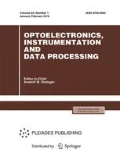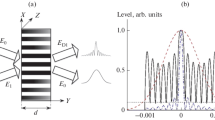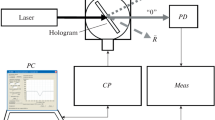Abstract
The effect of the photo-response nonlinearity of a holographic material on the achievable diffraction efficiency of holograms has been studied. It has been shown that the interaction between the hologram form factor and the photo-response nonlinearity leads to an increase in diffraction efficiency compared to a linear photo-response. Numerical calculations for the photo-response nonlinearity corresponding to Reoxan phase holographic material are presented.
Similar content being viewed by others
References
V. I. Sukhanov, A. V. Veniaminov, A. I. Ryskin, and N. V. Nikonorov, “Developments of State Optical Institute in the Area of Volume Recording Media for Holography, ” in Proceedings of the All-Russia Seminar “Yurii Nikolaevich Denisyuk — the Founder of Domestic Holography” (SPbGU ITMO, St. Petersburg, 2007), pp. 262–276 [in Russian].
V. V. Shelkovnikov, V. V. Russkikh, E. V. Vasil’ev, et al., “Photopolymeric Material Based on an Organic-Inorganic Sol-Gel Matrix for Holography,” Opt. Zh. 73 (7), 65–69 (2006).
I. S. Gibin and P. E. Tverdokhleb, “Influence of the Nonlinear Response of Photo Material in Holographic Recording of the Fourier Image of a Slit,” Radiotekhnika i Elektronika 16 (1), 71–76 (1971).
I. S. Gibin, E. F. Pen, and A. V. Trubetskoi, “Method of Selecting the Conditions for Recording Holograms,” Avtometriya, No. 3, 26–31 (1975).
S. A. Shoydin, “Diffraction Efficiency of Holograms Recorded with Gaussian Beams,” in Proceedings of the XI Intern. Sci. Congr. Interexpo Geo-Sibir’-2015 (SGUGiT, Novosibirsk, 2015), Vol. 1, pp. 71–76 [in Russian].
S. A. Shoydin, “Requirements to Lasers and Form Factor of Holograms,” Opt. Mem. & Neural Networks (Inform. Opt.) 23 (4), 287–294 (2014).
S. A. Shoydin, “Requirements to Lasers and Form Factor of Holograms,” Opt. Zh. 83 (5), 65–75 (2016).
S. A. Shoydin, “A Method of Achieving the Maximum Diffraction Efficiency of Holograms Based on Optimizing the Form Factor,” Komp. Optika 40 (4), 501–507 (2016).
R. J. Collier, C. B. Burkhardt, and L. H. Lin, Optical Holography (Academic, New York, 1971; Mir, Moscow, 1973).
S. A. Shoydin and E. A. Sander, “Recording Holograms in Dynamic Media without Relaxation,” Opt. Spektr. 58 (1), 200–202 (1985).
O. V. Andreeva, B. G. Manukhin, and N. V. Andreeva, “Reversible and Irreversible Changes in the Optical Parameters of Diffen Polymer Material due to Exposure to Radiation, ” in Abstracts of the XIVth Intern. Conf. “Holography: Science and Practice” (HOLOEXPO 2017) (Bauman MSTU, Moscow, 2017), pp. 195–197.
Author information
Authors and Affiliations
Corresponding author
Additional information
Russian Text © S.A. Shoydin, 2019, published in Avtometriya, 2019, Vol. 55, No. 1, pp. 35–39.
About this article
Cite this article
Shoydin, S.A. Effect of Photo-response Nonlinearity on the Diffraction Efficiency of Holograms. Optoelectron.Instrument.Proc. 55, 28–31 (2019). https://doi.org/10.3103/S8756699019010059
Received:
Revised:
Accepted:
Published:
Issue Date:
DOI: https://doi.org/10.3103/S8756699019010059




